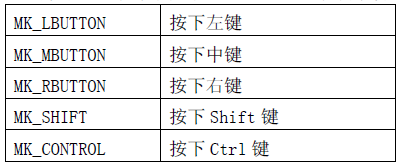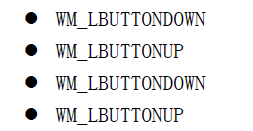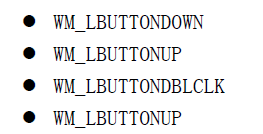现代计算机中除了键盘作为输入设备,更常用的还有鼠标。可以通过API来确定系统中是否存在鼠标并可以自定义界面上显示鼠标指针形状。鼠标的按键比键盘少,而且能进行的操作就是按下、抬起、移动,与键盘一样用户不需要直接处理指标的硬件信号,系统将这些动作都转化为虚拟按键消息发给程序。
fMouse = GetSystemMetrics (SM_MOUSEPRESENT) ; //判断鼠标是否存在
wndclass.hCursor = LoadCursor (NULL, IDC_ARROW) ; //载入预定义的鼠标形状IDC_ARROW
而Msg中的lparam和wparam分别包含了位置信息和按键信息:
x = LOWORD (lParam) ;
y = HIWORD (lParam) ;
wparam & MK_SHIFT
与键盘不同的是,除了鼠标消息被拦截和有模态窗口外,非活动窗口也能够收到鼠标消息(PS:模态窗口其实也是拦截消息)。
/*--------------------------------------------------
CONNECT.C -- Connect-the-Dots Mouse Demo Program
(c) Charles Petzold, 1998
--------------------------------------------------*/
#include <windows.h>
#define MAXPOINTS 1000
//窗口处理函数回调
LRESULT CALLBACK WndProc (HWND, UINT, WPARAM, LPARAM) ;
//建立框架
int WINAPI WinMain (HINSTANCE hInstance, HINSTANCE hPrevInstance,
PSTR szCmdLine, int iCmdShow)
{
static TCHAR szAppName[] = TEXT ("Connect") ;
HWND hwnd ;
MSG msg ;
WNDCLASS wndclass ;
wndclass.style = CS_HREDRAW | CS_VREDRAW ;
wndclass.lpfnWndProc = WndProc ;
wndclass.cbClsExtra = 0 ;
wndclass.cbWndExtra = 0 ;
wndclass.hInstance = hInstance ;
wndclass.hIcon = LoadIcon (NULL, IDI_APPLICATION) ;
wndclass.hCursor = LoadCursor (NULL, IDC_ARROW) ; //默认的鼠标形状
wndclass.hbrBackground = (HBRUSH) GetStockObject (WHITE_BRUSH) ;
wndclass.lpszMenuName = NULL ;
wndclass.lpszClassName = szAppName ;
if (!RegisterClass (&wndclass))
{
MessageBox (NULL, TEXT ("Program requires Windows NT!"),
szAppName, MB_ICONERROR) ;
return 0 ;
}
hwnd = CreateWindow (szAppName, TEXT ("Connect-the-Points Mouse Demo"),
WS_OVERLAPPEDWINDOW,
CW_USEDEFAULT, CW_USEDEFAULT,
CW_USEDEFAULT, CW_USEDEFAULT,
NULL, NULL, hInstance, NULL) ;
ShowWindow (hwnd, iCmdShow) ;
UpdateWindow (hwnd) ;
while (GetMessage (&msg, NULL, 0, 0))
{
TranslateMessage (&msg) ;
DispatchMessage (&msg) ;
}
return msg.wParam ;
}
LRESULT CALLBACK WndProc (HWND hwnd, UINT message, WPARAM wParam, LPARAM lParam)
{
static POINT pt[MAXPOINTS] ;
static int iCount ;
HDC hdc ;
int i, j ;
PAINTSTRUCT ps ;
switch (message)
{
case WM_LBUTTONDOWN: //左键按下 清理之前的点
iCount = 0 ;
InvalidateRect (hwnd, NULL, TRUE) ;
return 0 ;
case WM_MOUSEMOVE: //鼠标移动
// 是否移动的同时按住左键,保存的点个数不超过1000
if (wParam & MK_LBUTTON && iCount < 1000)
{
//保存点 并增加icount
pt[iCount ].x = LOWORD (lParam) ;
pt[iCount++].y = HIWORD (lParam) ;
// 在鼠标的当前位置上画点
hdc = GetDC (hwnd) ;
SetPixel (hdc, LOWORD (lParam), HIWORD (lParam), 0) ;
ReleaseDC (hwnd, hdc) ;
}
return 0 ;
case WM_LBUTTONUP: // 鼠标左键,抬起时刷新
InvalidateRect (hwnd, NULL, FALSE) ;
return 0 ;
case WM_PAINT: //画图
hdc = BeginPaint (hwnd, &ps) ;
//改变鼠标形状为IDC_WAIT
SetCursor (LoadCursor (NULL, IDC_WAIT)) ;
ShowCursor (TRUE) ;
// 所有点连线
for (i = 0 ; i < iCount - 1 ; i++)
for (j = i + 1 ; j < iCount ; j++)
{
MoveToEx (hdc, pt[i].x, pt[i].y, NULL) ;
LineTo (hdc, pt[j].x, pt[j].y) ;
}
//鼠标设为正常
ShowCursor (FALSE) ;
SetCursor (LoadCursor (NULL, IDC_ARROW)) ;
EndPaint (hwnd, &ps) ;
return 0 ;
case WM_DESTROY:
PostQuitMessage (0) ;
return 0 ;
}
return DefWindowProc (hwnd, message, wParam, lParam) ;
}

而对于非显示区域的鼠标消息都是带NC的:
与显示区域的lparam基于客户区的坐标不同,非显示区域的鼠标消息lparam中所标识的x,y值是基于屏幕坐标的,使用如下接口在屏幕坐标与客户区互相转换:
ScreenToClient (hwnd, &pt) ;
ClientToScreen (hwnd, &pt) ;case WM_NCHITTEST:
return (LRESULT) HTNOWHERE ;/*-------------------------------------------------
CHECKER4.C -- Mouse Hit-Test Demo Program No. 4
(c) Charles Petzold, 1998
-------------------------------------------------*/
#include <windows.h>
#define DIVISIONS 5
//父窗口与子窗口的消息处理回调
LRESULT CALLBACK WndProc (HWND, UINT, WPARAM, LPARAM) ;
LRESULT CALLBACK ChildWndProc (HWND, UINT, WPARAM, LPARAM) ;
int idFocus = 0 ;
TCHAR szChildClass[] = TEXT ("Checker4_Child") ;
int WINAPI WinMain (HINSTANCE hInstance, HINSTANCE hPrevInstance,
PSTR szCmdLine, int iCmdShow)
{
//注册主窗口类型
static TCHAR szAppName[] = TEXT ("Checker4") ;
HWND hwnd ;
MSG msg ;
WNDCLASS wndclass ;
wndclass.style = CS_HREDRAW | CS_VREDRAW ;
wndclass.lpfnWndProc = WndProc ;
wndclass.cbClsExtra = 0 ;
wndclass.cbWndExtra = 0 ;
wndclass.hInstance = hInstance ;
wndclass.hIcon = LoadIcon (NULL, IDI_APPLICATION) ;
wndclass.hCursor = LoadCursor (NULL, IDC_ARROW) ;
wndclass.hbrBackground = (HBRUSH) GetStockObject (WHITE_BRUSH) ;
wndclass.lpszMenuName = NULL ;
wndclass.lpszClassName = szAppName ;
if (!RegisterClass (&wndclass))
{
MessageBox (NULL, TEXT ("Program requires Windows NT!"),
szAppName, MB_ICONERROR) ;
return 0 ;
}
//注册子窗口类型
//注意!这里设置了cbWndExtra用于保存状态通过GetWindowLong\SetWindowLong中使用
wndclass.lpfnWndProc = ChildWndProc ;
wndclass.cbWndExtra = sizeof (long) ;
wndclass.hIcon = NULL ;
wndclass.lpszClassName = szChildClass ;
RegisterClass (&wndclass) ;
//创建主窗口(中间会产生create消息,并在create中创建子窗口)
hwnd = CreateWindow (szAppName, TEXT ("Checker4 Mouse Hit-Test Demo"),
WS_OVERLAPPEDWINDOW,
CW_USEDEFAULT, CW_USEDEFAULT,
CW_USEDEFAULT, CW_USEDEFAULT,
NULL, NULL, hInstance, NULL) ;
ShowWindow (hwnd, iCmdShow) ;
UpdateWindow (hwnd) ;
//消息驱动
while (GetMessage (&msg, NULL, 0, 0))
{
TranslateMessage (&msg) ;
DispatchMessage (&msg) ;
}
return msg.wParam ;
}
//主窗口处理回调函数
LRESULT CALLBACK WndProc (HWND hwnd, UINT message, WPARAM wParam, LPARAM lParam)
{
static HWND hwndChild[DIVISIONS][DIVISIONS] ; //保存所有子窗口的窗口句柄
int cxBlock, cyBlock, x, y ;
switch (message)
{
case WM_CREATE : //窗口创建消息
// 创建子窗口(WS_CHILDWINDOW,设置父窗口为hwnd)
for (x = 0 ; x < DIVISIONS ; x++)
for (y = 0 ; y < DIVISIONS ; y++)
hwndChild[x][y] = CreateWindow (szChildClass, NULL,
WS_CHILDWINDOW | WS_VISIBLE,
0, 0, 0, 0,
hwnd, (HMENU) (y << 8 | x),
(HINSTANCE) GetWindowLong (hwnd, GWL_HINSTANCE),
NULL) ;
return 0 ;
case WM_SIZE : //窗口大小变化(创建的时候会有一次)
cxBlock = LOWORD (lParam) / DIVISIONS ;
cyBlock = HIWORD (lParam) / DIVISIONS ;
//移动子窗口到合适的位置
for (x = 0 ; x < DIVISIONS ; x++)
for (y = 0 ; y < DIVISIONS ; y++)
MoveWindow (hwndChild[x][y],
x * cxBlock, y * cyBlock,
cxBlock, cyBlock, TRUE) ;
return 0 ;
case WM_LBUTTONDOWN : //在主窗口中单击
MessageBeep (0) ;
return 0 ;
// On set-focus message, set focus to child window
case WM_SETFOCUS: //在主窗口获得焦点时立即将焦点设置到之前设置为焦点的子窗口
SetFocus (GetDlgItem (hwnd, idFocus)) ;
return 0 ;
// On key-down message, possibly change the focus window
case WM_KEYDOWN: //处理主窗口的键盘消息
//获得当前获得窗口的子窗口行列值
x = idFocus & 0xFF ;
y = idFocus >> 8 ;
//计算按键后应当获得焦点的子窗口行列值
switch (wParam)
{
case VK_UP: y-- ; break ;
case VK_DOWN: y++ ; break ;
case VK_LEFT: x-- ; break ;
case VK_RIGHT: x++ ; break ;
case VK_HOME: x = y = 0 ; break ;
case VK_END: x = y = DIVISIONS - 1 ; break ;
default: return 0 ;
}
x = (x + DIVISIONS) % DIVISIONS ;
y = (y + DIVISIONS) % DIVISIONS ;
//设置并保存焦点对象
idFocus = y << 8 | x ;
SetFocus (GetDlgItem (hwnd, idFocus)) ;
return 0 ;
case WM_DESTROY :
PostQuitMessage (0) ;
return 0 ;
}
return DefWindowProc (hwnd, message, wParam, lParam) ;
}
//子窗口处理回调函数
LRESULT CALLBACK ChildWndProc (HWND hwnd, UINT message,
WPARAM wParam, LPARAM lParam)
{
HDC hdc ;
PAINTSTRUCT ps ;
RECT rect ;
switch (message)
{
case WM_CREATE : //create消息 cbWndExtra状态都设置为0
SetWindowLong (hwnd, 0, 0) ; // on/off flag
return 0 ;
case WM_KEYDOWN: //获取焦点后键盘消息直接发送到这里
// Send most key presses to the parent window
if (wParam != VK_RETURN && wParam != VK_SPACE)
{
//发回给父窗口处理
SendMessage (GetParent (hwnd), message, wParam, lParam) ;
return 0 ;
}
// For Return and Space, fall through to toggle the square
case WM_LBUTTONDOWN : //左键单击消息,cbWndExtra设置为反,并设置为焦点,重画
SetWindowLong (hwnd, 0, 1 ^ GetWindowLong (hwnd, 0)) ;
SetFocus (hwnd) ;
InvalidateRect (hwnd, NULL, FALSE) ;
return 0 ;
// For focus messages, invalidate the window for repaint
case WM_SETFOCUS: //上边的代码设置焦点会先到这里,设置GWL_ID
idFocus = GetWindowLong (hwnd, GWL_ID) ;
// Fall through
case WM_KILLFOCUS: //失去焦点也要重画
InvalidateRect (hwnd, NULL, TRUE) ;
return 0 ;
case WM_PAINT : //cbWndExtra为1的时候画叉,有焦点的时候画框
hdc = BeginPaint (hwnd, &ps) ;
GetClientRect (hwnd, &rect) ;
Rectangle (hdc, 0, 0, rect.right, rect.bottom) ;
// Draw the "x" mark
if (GetWindowLong (hwnd, 0))
{
MoveToEx (hdc, 0, 0, NULL) ;
LineTo (hdc, rect.right, rect.bottom) ;
MoveToEx (hdc, 0, rect.bottom, NULL) ;
LineTo (hdc, rect.right, 0) ;
}
// Draw the "focus" rectangle
if (hwnd == GetFocus ())
{
rect.left += rect.right / 10 ;
rect.right -= rect.left ;
rect.top += rect.bottom / 10 ;
rect.bottom -= rect.top ;
SelectObject (hdc, GetStockObject (NULL_BRUSH)) ;
SelectObject (hdc, CreatePen (PS_DASH, 0, 0)) ;
Rectangle (hdc, rect.left, rect.top, rect.right, rect.bottom) ;
DeleteObject (SelectObject (hdc, GetStockObject (BLACK_PEN))) ;
}
EndPaint (hwnd, &ps) ;
return 0 ;
}
return DefWindowProc (hwnd, message, wParam, lParam) ;
}
/*---------------------------------------------------
BLOKOUT2.C -- Mouse Button & Capture Demo Program
(c) Charles Petzold, 1998
---------------------------------------------------*/
#include <windows.h>
LRESULT CALLBACK WndProc (HWND, UINT, WPARAM, LPARAM) ;
//建立框架
int WINAPI WinMain (HINSTANCE hInstance, HINSTANCE hPrevInstance,
PSTR szCmdLine, int iCmdShow)
{
static TCHAR szAppName[] = TEXT ("BlokOut2") ;
HWND hwnd ;
MSG msg ;
WNDCLASS wndclass ;
wndclass.style = CS_HREDRAW | CS_VREDRAW ;
wndclass.lpfnWndProc = WndProc ;
wndclass.cbClsExtra = 0 ;
wndclass.cbWndExtra = 0 ;
wndclass.hInstance = hInstance ;
wndclass.hIcon = LoadIcon (NULL, IDI_APPLICATION) ;
wndclass.hCursor = LoadCursor (NULL, IDC_ARROW) ;
wndclass.hbrBackground = (HBRUSH) GetStockObject (WHITE_BRUSH) ;
wndclass.lpszMenuName = NULL ;
wndclass.lpszClassName = szAppName ;
if (!RegisterClass (&wndclass))
{
MessageBox (NULL, TEXT ("Program requires Windows NT!"),
szAppName, MB_ICONERROR) ;
return 0 ;
}
hwnd = CreateWindow (szAppName, TEXT ("Mouse Button & Capture Demo"),
WS_OVERLAPPEDWINDOW,
CW_USEDEFAULT, CW_USEDEFAULT,
CW_USEDEFAULT, CW_USEDEFAULT,
NULL, NULL, hInstance, NULL) ;
ShowWindow (hwnd, iCmdShow) ;
UpdateWindow (hwnd) ;
while (GetMessage (&msg, NULL, 0, 0))
{
TranslateMessage (&msg) ;
DispatchMessage (&msg) ;
}
return msg.wParam ;
}
//画方框
void DrawBoxOutline (HWND hwnd, POINT ptBeg, POINT ptEnd)
{
HDC hdc ;
hdc = GetDC (hwnd) ;
//设置反色
SetROP2 (hdc, R2_NOT) ;
SelectObject (hdc, GetStockObject (NULL_BRUSH)) ;
Rectangle (hdc, ptBeg.x, ptBeg.y, ptEnd.x, ptEnd.y) ;
ReleaseDC (hwnd, hdc) ;
}
LRESULT CALLBACK WndProc (HWND hwnd, UINT message, WPARAM wParam, LPARAM lParam)
{
static BOOL fBlocking, fValidBox ;
static POINT ptBeg, ptEnd, ptBoxBeg, ptBoxEnd ;
HDC hdc ;
PAINTSTRUCT ps ;
switch (message)
{
case WM_LBUTTONDOWN : //鼠标起始点
ptBeg.x = ptEnd.x = LOWORD (lParam) ;
ptBeg.y = ptEnd.y = HIWORD (lParam) ;
//画方框
DrawBoxOutline (hwnd, ptBeg, ptEnd) ;
//设置capture在鼠标移动到窗口之外还能获取消息
SetCapture (hwnd) ;
//设置鼠标成十字星
SetCursor (LoadCursor (NULL, IDC_CROSS)) ;
fBlocking = TRUE ;
return 0 ;
case WM_MOUSEMOVE : //鼠标移动
//是否拖动
if (fBlocking)
{
SetCursor (LoadCursor (NULL, IDC_CROSS)) ;
//在之前的方框上画一边反色,恢复成背景色
DrawBoxOutline (hwnd, ptBeg, ptEnd) ;
ptEnd.x = LOWORD (lParam) ;
ptEnd.y = HIWORD (lParam) ;
//画新的方框
DrawBoxOutline (hwnd, ptBeg, ptEnd) ;
}
return 0 ;
case WM_LBUTTONUP : //放松左键,由于设置了SetCapture,就算鼠标移出窗口也可以收到这个消息
if (fBlocking)
{
//在之前的方框上画一边反色,恢复成背景色
DrawBoxOutline (hwnd, ptBeg, ptEnd) ;
ptBoxBeg = ptBeg ;
ptBoxEnd.x = LOWORD (lParam) ;
ptBoxEnd.y = HIWORD (lParam) ;
//释放Capture
ReleaseCapture () ;
//恢复鼠标图标
SetCursor (LoadCursor (NULL, IDC_ARROW)) ;
fBlocking = FALSE ;
fValidBox = TRUE ;
InvalidateRect (hwnd, NULL, TRUE) ;
}
return 0 ;
case WM_CHAR : //处理按键消息,再拖动的过程中释放Capture,并恢复
if (fBlocking & (wParam == '\x1B')) // i.e., Escape
{
DrawBoxOutline (hwnd, ptBeg, ptEnd) ;
ReleaseCapture () ;
SetCursor (LoadCursor (NULL, IDC_ARROW)) ;
fBlocking = FALSE ;
}
return 0 ;
case WM_PAINT :
hdc = BeginPaint (hwnd, &ps) ;
//画边框
if (fValidBox)
{
SelectObject (hdc, GetStockObject (BLACK_BRUSH)) ;
Rectangle (hdc, ptBoxBeg.x, ptBoxBeg.y,
ptBoxEnd.x, ptBoxEnd.y) ;
}
//填充色块
if (fBlocking)
{
SetROP2 (hdc, R2_NOT) ;
SelectObject (hdc, GetStockObject (NULL_BRUSH)) ;
Rectangle (hdc, ptBeg.x, ptBeg.y, ptEnd.x, ptEnd.y) ;
}
EndPaint (hwnd, &ps) ;
return 0 ;
case WM_DESTROY :
PostQuitMessage (0) ;
return 0 ;
}
return DefWindowProc (hwnd, message, wParam, lParam) ;
}
























 1812
1812

 被折叠的 条评论
为什么被折叠?
被折叠的 条评论
为什么被折叠?








